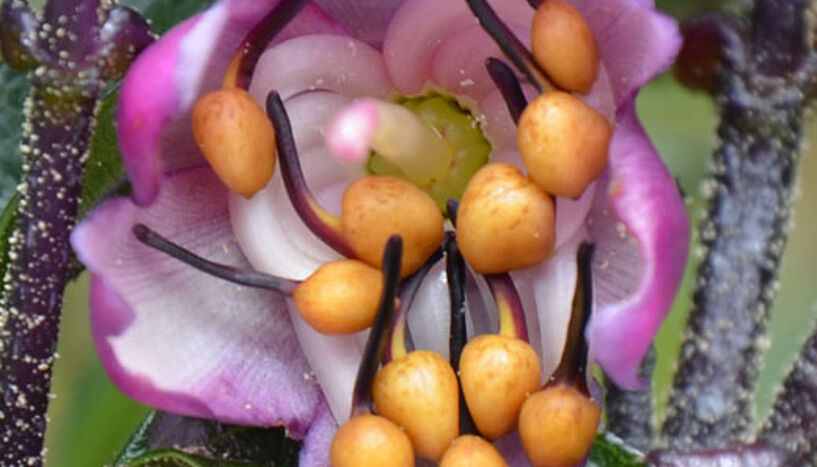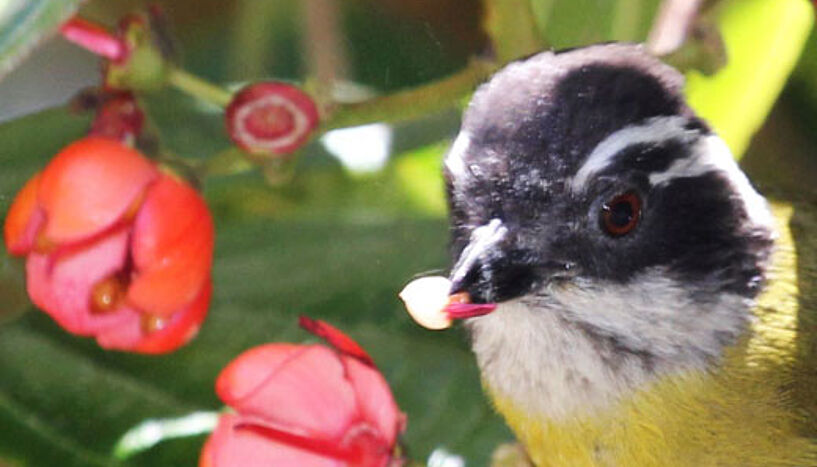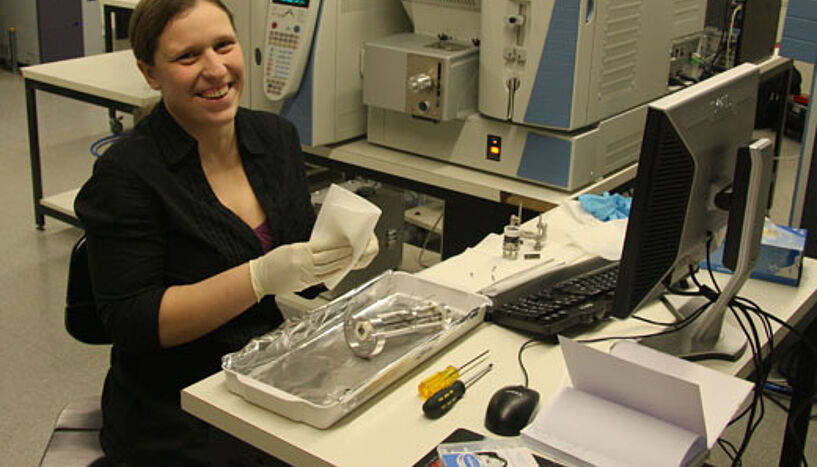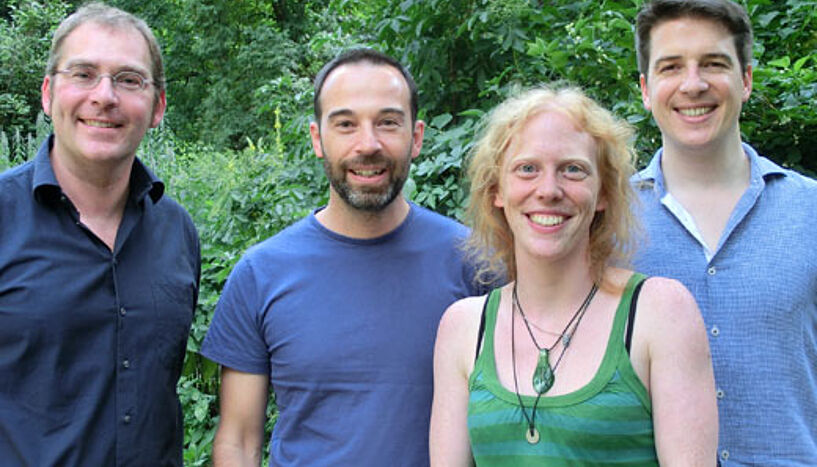Novel type of bird pollination mechanism discovered in South America
03. Juli 2014Birds do not feed on nectar but consume the male reproductive organs
Interactions between flowering plants and their pollinators include some of the most elaborate and intriguing relationships known to science. Agnes Dellinger from the Department of Botany and Biodiversity Research of the University of Vienna and her co-authors have studied the pollination biology of a group of small trees or shrubs that occur in mountainous Central and South American rainforests. What they found is a most unusual relationship with the birds that pollinate the flowers of these plants. The results are now published in the high-impact journal Current Biology.
The genus Axinaea belongs to the large, mainly tropical flowering plant family Melastomataceae (Meadow Beauty Family). Most of the ca. 5000 species in the family rely on bees for their pollination. Only about 100 are known to be pollinated by other insects or vertebrates. The flowers of Axinaea appear in clusters of few to more than twenty flowers and the petals of the different species are pink, yellow, orange or red. The stamens (male reproductive organs) stand out based on the contrasting colours of their bulbous appendages. The pollination mechanism of Axinaea had never been studied before and the researchers (Agnes Dellinger, Yannick Staedler, Jürg Schönenberger (Department of Botany and Biodiversity Research), Lena Fragner, Wolfram Weckwerth (Department of Ecogenomics and Systems Biology) from the University of Vienna, and the California Academy of Sciences (Darin Penneys) were very surprised to find that the flowers of this genus are visited by birds (mainly tanagers).
Complex “bellows” organ
Even more surprising was the finding that the birds do not feed on nectar as in most other bird-pollinated plants but consume the male reproductive organs (the stamens) while visiting the flowers. It turns out that the birds are attracted to the flowers by the conspicuous and sugar-rich stamen-appendages of Axinaea. As the birds seize a stamen, they are blasted with pollen by the stamen’s complex “bellows” organ. And as the birds forage on, they deposit some of the pollen on a female floral organ (the stigma) and thus pollinate the flower.
Nutritious, sugar-rich food bodies as reward
Combining video monitoring and pollination experiments in the field with lab-based analyses of stamen structure and chemical composition, the researchers could describe the unique and highly complex pollination mechanism of Axinaea in detail. What they found is completely new to science and differs distinctly from known bird pollination systems. While the majority of bird-pollinated flowers offer nectar as reward, Axinaea attracts the birds with its nutritious, sugar-rich food bodies. In the rare known cases involving food bodies in bird pollinated systems, these rewards are restricted to the sterile outer floral organs. Also, there is no other known case of bird-pollinated plants that involves anatomically distinct bellows-organ for pollen dispersal.
At the more general level of the evolutionary history of flowering plant pollination, this study on the pollination biology of Axinaea provides another example for an evolutionary pollinator shift from bees to birds that is accompanied by conspicuous changes in floral morphology. Such evolutionary shifts from bees to birds or other vertebrates are often correlated with growth at higher altitudes and apparently support an earlier hypothesis postulating that vertebrates may be more reliable and more efficient pollinators at higher elevations than bees.
Publication in Current Biology:
Dellinger et al.: "A specialized bird pollination system involving a bellows mechanism for pollen transfer and staminal food body rewards" in Current Biology - July 21, 2014 issue.
DOI: 10.1016/
Scientific Contact
MSc. Agnes Dellinger
Department of Botany and Biodiversity Research
University of Vienna
1030 Vienna, Rennweg 14
T +43-1-4277-54083
agnes.dellinger(at)univie.ac.at
Univ.-Prof. Dr. Jürg Schönenberger
Department of Botany and Biodiversity Research
University of Vienna
1030 Vienna, Rennweg 14
T +43-1-4277-540 80
juerg.schoenenberger(at)univie.ac.at
Press Contact
Mag. Alexandra Frey
Press Office
University of Vienna
1010 Vienna, Universitätsring 1
T +43-1-4277-175 33
M +43-664-602 77-175 33
alexandra.frey(at)univie.ac.at
Wissenschaftlicher Kontakt
Agnes Dellinger, PhD
Department für Botanik und BiodiversitätsforschungUniversität Wien
1030 - Wien, Rennweg 14
+43-1-4277-54083
agnes.dellinger@univie.ac.at
Rückfragehinweis
Mag. Alexandra Frey
Media Relations ManagerUniversität Wien
1010 - Wien, Universitätsring 1
+43-1-4277-17533
+43-664-8175675
alexandra.frey@univie.ac.at
Downloads:
Figure1_Dellinger_01.jpg
Dateigröße: 216,08 KB
Figure2_Dellinger_01.jpg
Dateigröße: 145,81 KB
Figure3_Dellinger_01.jpg
Dateigröße: 4,38 MB
Figure4_Dellinger_01.JPG
Dateigröße: 3,38 MB




